New perk! Get after it with local recommendations just for you. Discover nearby events, routes out your door, and hidden gems when you sign up for the Local Running Drop.
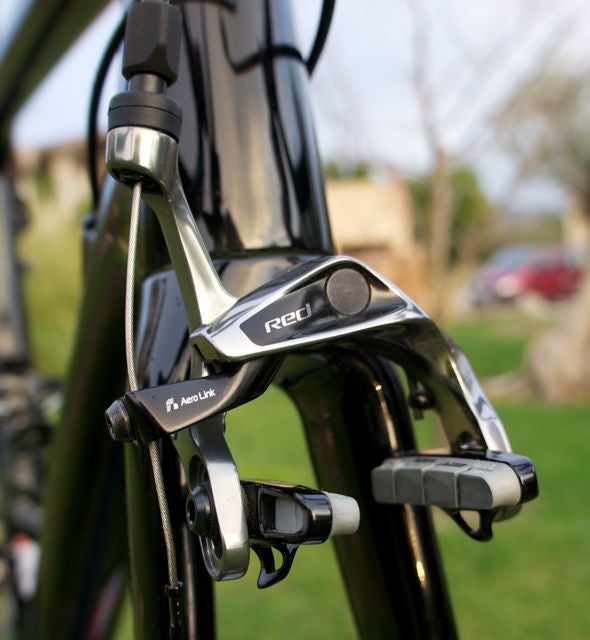
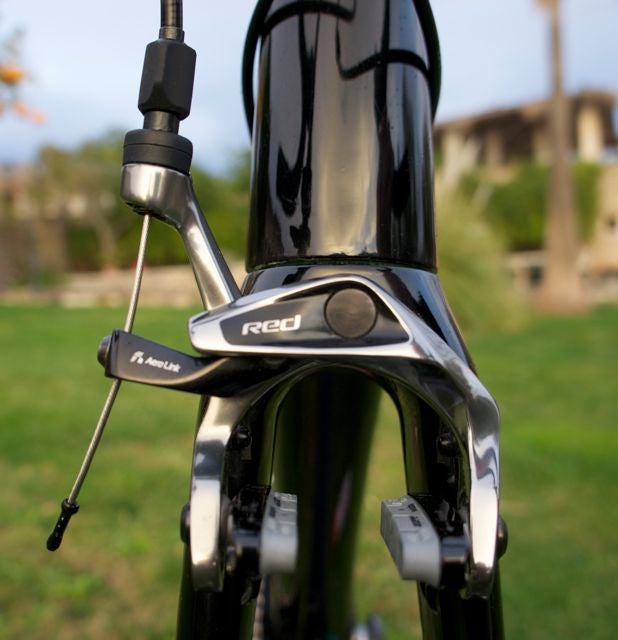
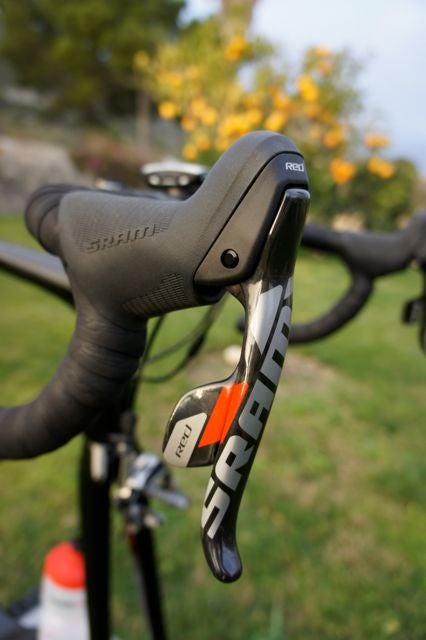
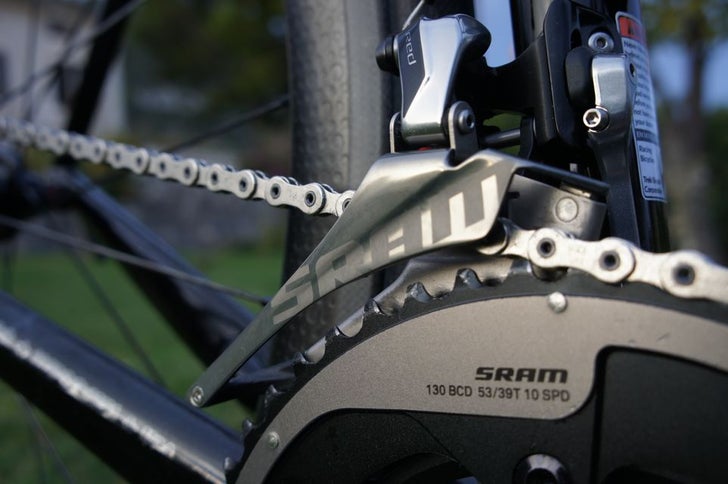
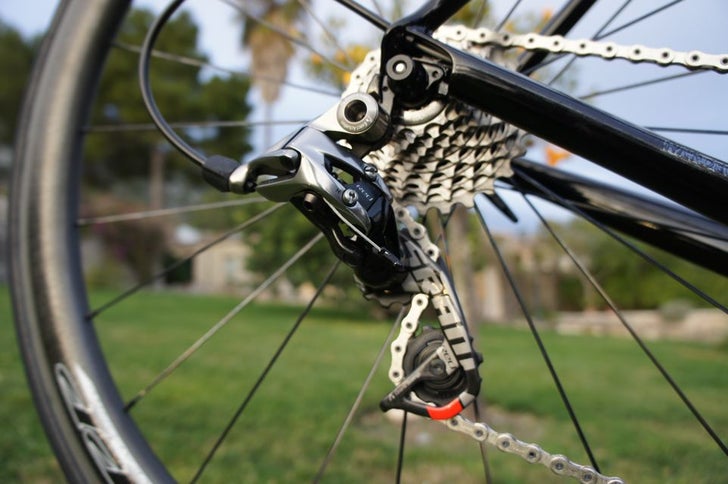
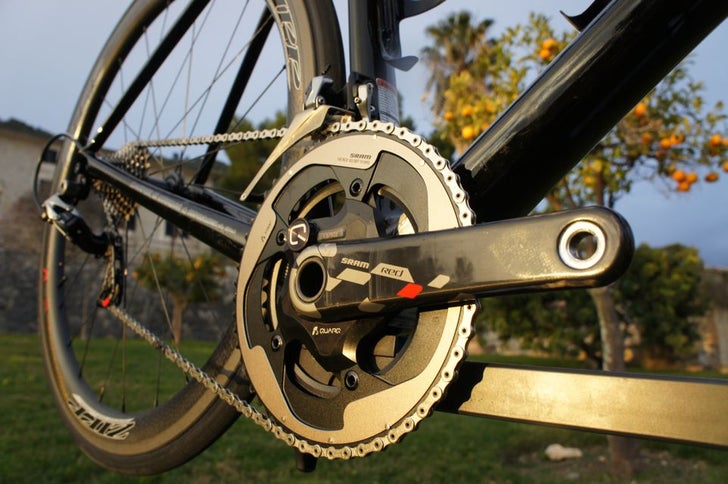
SRAM’s first complete overhaul to their premier Red groupset greatly improves upon the three weaknesses of the original kit. Although they haven’t created new triathlon shifters or followed the trend to electronic shifting, 2012 SRAM Red brakes stronger, front shifts faster (much faster) and makes less noise than its predecessor.
PHOTOS: 2012 SRAM Red Groupset
Front Shifting
The improvement in front shift performance from the original Red kit to the 2012 version is simply astonishing. SRAM engineers transformed this critical aspect of component performance from the group’s biggest weakness to one of its greatest strengths. A light flick of the new slightly larger shift lever catapults the chain from the small ring to the big without any grinding, skipping or mechanical feedback. The chain just goes. SRAM dramatically changed the front derailleur and the chainrings to achieve this outstanding shift performance.
The original Red front derailleur cage was made of titanium and flexed when shifting. Some professional road cyclists and triathletes sponsored by SRAM use the lower level Force front derailleur because it has a stiffer steel cage and shifts faster. The new Red derailleur is feather light, but doesn’t sacrifice stiffness. Instead of using a single material to construct the cage, SRAM used steel, aluminum and even a little carbon to build a cage that is light, stiff and pretty.
The wall of the derailleur cage closest to the frame is steel. Although it’s heavier, building this critical section of the derailleur with steel helps the cage keep its shape when pressed against the chain rather than giving way slightly, which can slow shifting. The front of the cage is forged aluminum. This material lightens the component and allows SRAM to shape the piece to a very specific subtle curve and give it a beautiful finish. The black inside portion of the derailleur’s tail is carbon composite press fitted and glued on to the steel segment. SRAM Design Engineer Mark Santurbane says this bond is plenty strong because the chain doesn’t pull directly against the carbon segment so there is very little stress on the bond.
In addition to the changes to the cage itself, SRAM fundamentally changed the way the derailleur moves when shifting. Most derailleur cages move straight to the side when shifted from the small ring position to the big. If you marked the position of the walls before and after shifting, they would be parallel to themselves. Although this simplistic movement can execute an accurate shift, existing systems using this derailleur movement require an intermediate front derailleur position to prevent the chain from rubbing against the chain in all gear combinations. SRAM added a twist in the front derailleur’s shift movement that allows the system to rapidly jump gears and eliminate the middle position entirely.
The tail of the derailleur is pointed toward the center of the cassette whether in the big ring or the small. When the derailleur drops to the small ring position, the tail of the cage—the rearmost part—doesn’t move in toward the bike as far as the front of the cage. As a result, the cage ends up pointing slightly outward from the bike. This unique movement prevents the chain from rubbing in almost any gear combination. We were able to get a tiny amount of chain rub when in the 39-11 combination, but there wasn’t a whisper in any other combination, even while cross-chaining in the big-big 53-23 gear combination. Although the ability to cross chain with impunity is a major bonus, the biggest improvement is simply the speed, ease and accuracy with which the kit up-shifts.
Upshifting to the big ring using the 2011 Red kit required a bit of cajoling, but the 2012 shifts with amazing speed and precision. Since the middle trim position has been eliminated, a light flick on the shifter is all it takes. Front shifting felt amazing compared to any mechanical component kit, and shockingly close to the performance of Shimano Di2 electronic groups. The chain would shift from any gear combination and even under a lot of load.
The chainrings are the other redesigned components that make this superior shifting performance possible. After much trial and error while working around the existing patents held by Shimano and Campagnolo, SRAM found a combination of ramps and pins that accelerate front shifting.
The front derailleur comes with a chain catcher that can be adjusted independent of the derailleur to prevent the chain from falling off the chainrings onto the frame.
Along with the standard crank, SRAM is offering a Quarq power meter built into the Red crank.
Rear Shifting
Rear shift performance of the new 2012 Red kit feels very similar to the 2011 Red group. SRAM kept their 1:1 cable pull-to-derailleur movement ratio. It still has that definite click and feeling of solid resistance, but the whirring, clanking and reverberating of last year’s Red kit is gone.
2011 Red shifts very precisely, but makes a lot of noise due in part to the hollow cassette and derailleur pulley tooth design. The hollow cassette design is gone, although most of the cogs are still constructed in a single unit. All cogs but the largest are machined from a single block of steel and connected to each other. The biggest ring is aluminum. Holes are drilled between the larger cogs to save weight and elastic rings are slotted between the cogs to help quietly guide the chain on to the cogs.
The idea behind these elastomers SRAM has dubbed “StealthRing” is to provide a soft surface to catch the chain as it is guided on to the lower segment of the cassette under minimal tension. A deeper trough is machined from the rear half of each grove and the elastomer protrudes slightly into this gap. As the chain links move from to the top of the cassette and gradually accept more of the load, the links are pulled off the elastomer and into contact with the metal tooth only. Durability of these rubber parts is the obvious question but SRAM’s initial ride and lab testing shows that the elastomers last a very long time, although not quite as long as a cassette in some cases. Should they degrade or break, SRAM offers replacement rings. The system should continue to work if one breaks.
The other change intended to quiet the rear part of the component group was made to the derailleur pulleys. The old pulleys have blunted teeth that make a whirring sound when the chain rolls onto them. The side of each tooth that first connects with the chain has been narrowed to smooth that transition.
Although we can’t say which change is responsible for the improvement, the rear of the bike is much, much quieter. Riding in a pack of bikes built with 2011 Red is cacophonous, but the group of bikes on our test ride was whisper quiet.
The standard derailleur can accommodate a cassette with a climbing gear up to 28 teeth and a version capable of fitting SRAM’s cassette with a 32-tooth cog will come later in the year.
Ergonomics
The grip points of a triathlon bike built with 2012 Red won’t change. The 500TT traditional-style shifter will continue to work with the new kit. SRAM’s R2C rear shifter is compatible with the new group, but the front shifter has unnecessary front trim shift positions. Both rear and front will work with the new stuff, but only the rear is optimized for it. SRAM hasn’t announced any plans to dramatically change the triathlon shifters, but a version of R2C specifically designed for 2012 Red is in the works.
The road shift hood went through several small changes. The circumference around the meat of the shifter is smaller, making it easier to get a hand all the way around the component. The bump at the front of the shifter is bigger and kicks up more dramatically from the shifter body.
The step up from the top of a road bar to the rearmost portion of the shifter hood is gone. The new design has a much smoother transition to remove that former hotspot.
The shifter paddle is slightly larger, but it isn’t a dramatic change. The brake lever’s curvature was also tweaked.
Like 2011 Red, both the shift lever and brake lever positions can be set to rider preference using four indexed positions. The screw that adjusts shifter reach is now much easier to access. A 2.5mm Allen bolt is exposed on the on the lever’s inside face.
The smooth brake hood cover was replaced with a textured alternative. We found the old version to be more than sufficiently sticky and this one also does the job well.
Braking
The new brakes are much smaller than the older versions. Aerodynamicists from multiple bike frame companies have stated that a front brake creates substantially more drag when it protrudes beyond the fork. SRAM says that improving aerodynamic performance was one of their primary goals when designing this kit and the brake seems to be a big part of that directive.
SRAM abandoned the dual-pivot caliper design used in their original groups and by Shimano in favor of a single-pivot design. We think original Red brakes felt less stiff than brakes from the other two big component companies and the new brake solve that problem. The caliper doesn’t give way under strong braking force. SRAM also designed a unique brake arm that increases the force pinching down on the rim as the rider squeezes harder on the brake lever.
The cable pinch bolt is at the end of a lever arm that cams to put the cable further from the pivot bolt when squeezed tighter, which increases the pressure on the rim. This clever design allows for more accurate modulation when apply light stopping force but gives a slight kick to stopping power when needed. It only changes leverage as the system flexes after the pads are already in contact with the rim, so the difference in leverage feels minimal. It doesn’t abruptly grab the rim as the rider squeezes tighter on the lever.
Each arm has a sunken screw to adjust lateral position. The quick release was moved from the cable pinch bolt to just beneath the barrel adjuster. The brake can fit wheels up to 31mm wide—3mm wider than the widest wheel we are aware of.
Hydraulic Brakes Coming
The rumors about SRAM’s hydraulic road brakes were true. They’re working on it, but aren’t finished yet. By the fall of this year, SRAM plans to have both hydraulic rim and disc brakes specifically for road bikes integrated with 2012 Red road shifters. Tri-specific hydraulic brakes are not on that same timeline, so Magura may have a monopoly on hydraulic brakes for triathlon bikes this year.
Weights, Prices And Availability
The complete groupset without cables or housing weighs 1,739 grams with a 172.5mm crank and 53/39 chainrings. SRAM says the kit is 311 grams lighter than the comparable Shimano Dura-Ace cassette. It will be available in March.
Shifters: 280 grams, $639
500TT shifters: 154 grams, $132
Rear derailleur: 145 grams, $358
Front derailleur: 86 grams, $137
Crankset: BB30 557 grams, $494 w/o BB. GXP 609 grams, $451. BB30 version will be available in May.
Brakeset: 240 grams, $351
Cassette: 135 grams, $335
Quarq power meter crank: GXP 778 grams $1,995. BB30 $2,045.
Bottom bracket: BB30 53 grams, $236. GXP 105 grams, $220.
Chain: 255 grams, $84
$2,127 with BB30 and tri shifters.
$2,634 with BB30 and road shifters.